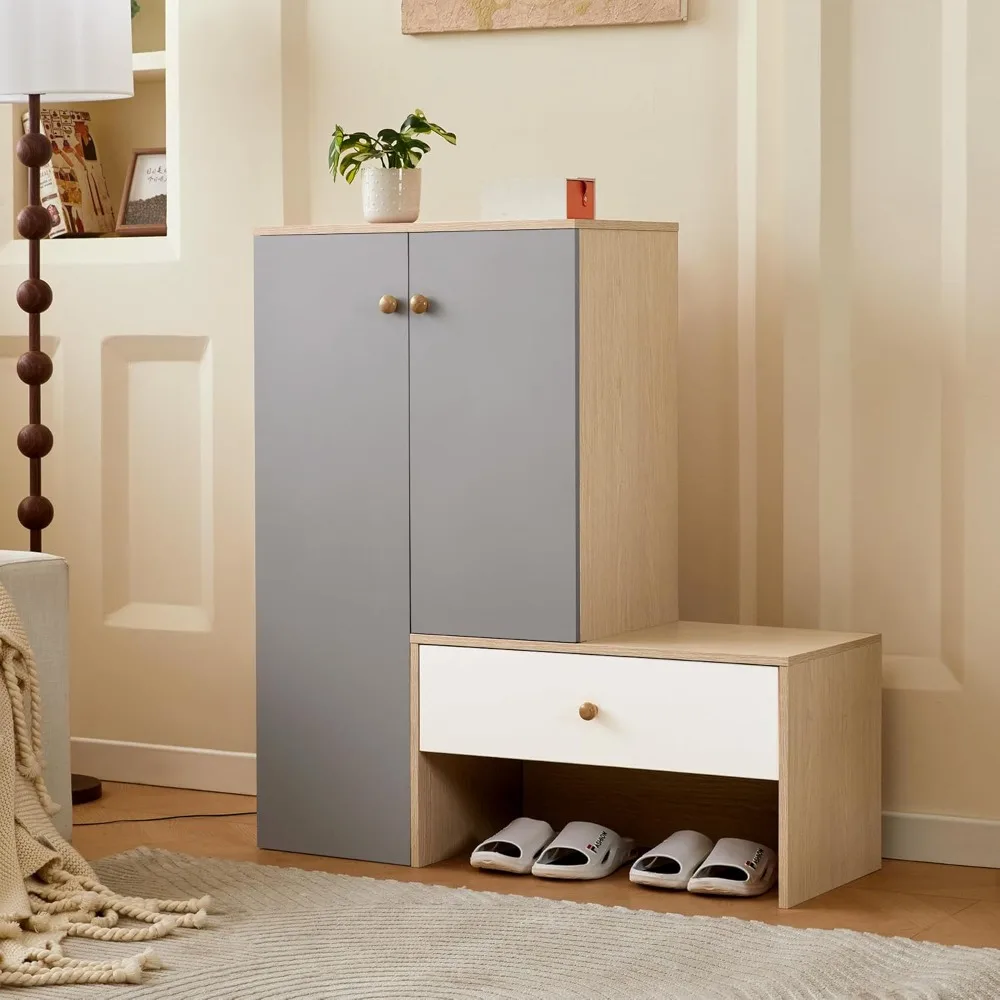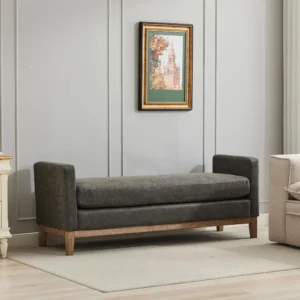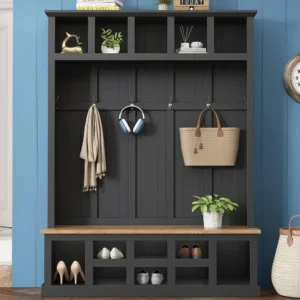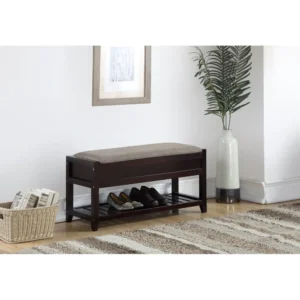The Strategic Advantage: Why Open Shelving Transforms Mudrooms
Open shelving stands as a game-changer for mudroom design, offering far more than just a place to store your belongings. Unlike closed cabinetry that hides clutter behind doors, open shelving creates an immediate visual impact while maintaining exceptional functionality. This storage approach transforms your entryway by creating an illusion of more space—particularly valuable in typically compact mudroom areas.
The visual accessibility of open shelving provides remarkable practical benefits. Studies suggest that families save an average of 10-15 minutes during busy morning routines when essential items are visible rather than hidden behind cabinet doors. This visibility creates accountability, encouraging family members to maintain organization rather than stuffing items behind closed doors.
Beyond practical advantages, open shelving offers design versatility that adapts to virtually any home style—from minimalist modern to cozy farmhouse. The adaptable nature of open shelving also presents a cost-effective alternative to custom cabinetry, often reducing storage solution expenses by 30-40% while providing similar functionality.
The principles behind effective space-saving benches apply similarly to open shelving design—both maximize functional use while minimizing visual weight in transitional spaces. When implemented strategically, open shelving creates a psychological benefit by making your space feel intentionally designed rather than simply utilitarian.
For those with limited square footage, learning how to organize a small entryway becomes significantly easier with the implementation of thoughtful open shelving that makes the most of vertical space while maintaining accessibility.
Accessibility & Visibility Benefits: The Practical Advantages
The most immediate benefit of open shelving is the visual accessibility it provides. When morning routines become hectic and time is short, being able to see everything at a glance can make all the difference.
Consider this common scenario: It’s 7:45 AM on a Tuesday. Everyone needs to leave in 10 minutes. With open shelving, each family member can quickly:
– Locate their specific items without opening and closing multiple cabinet doors
– See at a glance if something is missing before heading out
– Grab essentials without disrupting the organization of the entire space
– Return items to their designated spots without extra steps
This visibility naturally encourages better organizational habits. When items are in plain sight, there’s gentle pressure to maintain order—you can’t simply hide disorder behind closed doors. Many families report that open shelving systems reduce the frequency of the frantic “where is my…” morning search by up to 70%.
For busy households, complementing open shelving with dedicated mudroom benches creates the perfect functional entryway zone that supports smooth transitions between home and the outside world.
Design Impact: Creating Space & Style
In the typically compact dimensions of a mudroom (often just 6×8 feet), open shelving creates a dramatic sense of spaciousness that closed cabinetry simply cannot match. Without cabinet doors swinging open into the walkway, the entire room functions more efficiently while appearing visually lighter.
Open shelving transforms storage from purely functional to decoratively purposeful. The shelves themselves become architectural elements that draw the eye and add character to what might otherwise be a utilitarian space. This approach allows you to:
- Create visual interest with varied textures and materials
- Personalize the space through displayed items and containers
- Showcase decorative elements alongside practical necessities
- Add warmth through wood tones or industrial appeal through metal elements
For homeowners working with particularly tight spaces, implementing space-saving entryway ideas in conjunction with open shelving maximizes every square inch while maintaining an inviting, uncluttered appearance.
Essential Applications: Prime Uses for Open Shelving in Mudrooms
The most successful mudroom shelving systems are those designed with specific purposes in mind. Rather than creating generic storage, consider how your family actually uses this transitional space and what items consistently need homes.
- Family-specific zones: Designate specific shelf areas for each family member, scaled to their height and needs
- Seasonal priority sections: Organize shelves so currently needed seasonal items remain most accessible
- Frequency-based accessibility: Position daily essentials at easy-reach levels, with less-used items higher or lower
- Visual-functional balance: Create a system where practical items blend harmoniously with decorative elements
Effective zoning prevents the common mudroom challenge of “dumping,” where items are haphazardly placed on any available surface. By creating designated areas with specific purposes, you establish an intuitive system that naturally encourages organization.
Many homeowners find that pairing open shelving with mudroom bench shoe storage creates a comprehensive solution that addresses both seating and organization needs in one cohesive unit.
Daily Essentials Organization: Keeping Must-Haves Accessible
The most effective mudroom shelving systems prioritize daily-use items, keeping them within the “golden zone” of accessibility—between waist and eye level for the primary users.
For footwear organization, consider these practical applications:
– Reserve lower shelves (12-14 inches tall) for current-season shoes and boots
– Use shelf depths of 12-16 inches to accommodate adult footwear comfortably
– Implement boot trays on bottom shelves to catch moisture and dirt
– Consider angled shelving to display and access shoes more easily
For bags and backpacks, optimal organization requires:
– Shelf heights of 16-20 inches to accommodate most school backpacks and work bags
– Depth of 14-16 inches to support bags without excessive overhang
– Individual hooks or compartments to prevent items from becoming tangled
– Basket containment for smaller bags or accessories
For quick-grab essentials such as keys, sunglasses, and mail:
– Install shallow shelves (6-8 inches deep) at adult eye level
– Incorporate small containers or dividers to separate items by type or owner
– Position these items near the door for grab-and-go convenience
– Include a designated mail sorting system to prevent paper buildup
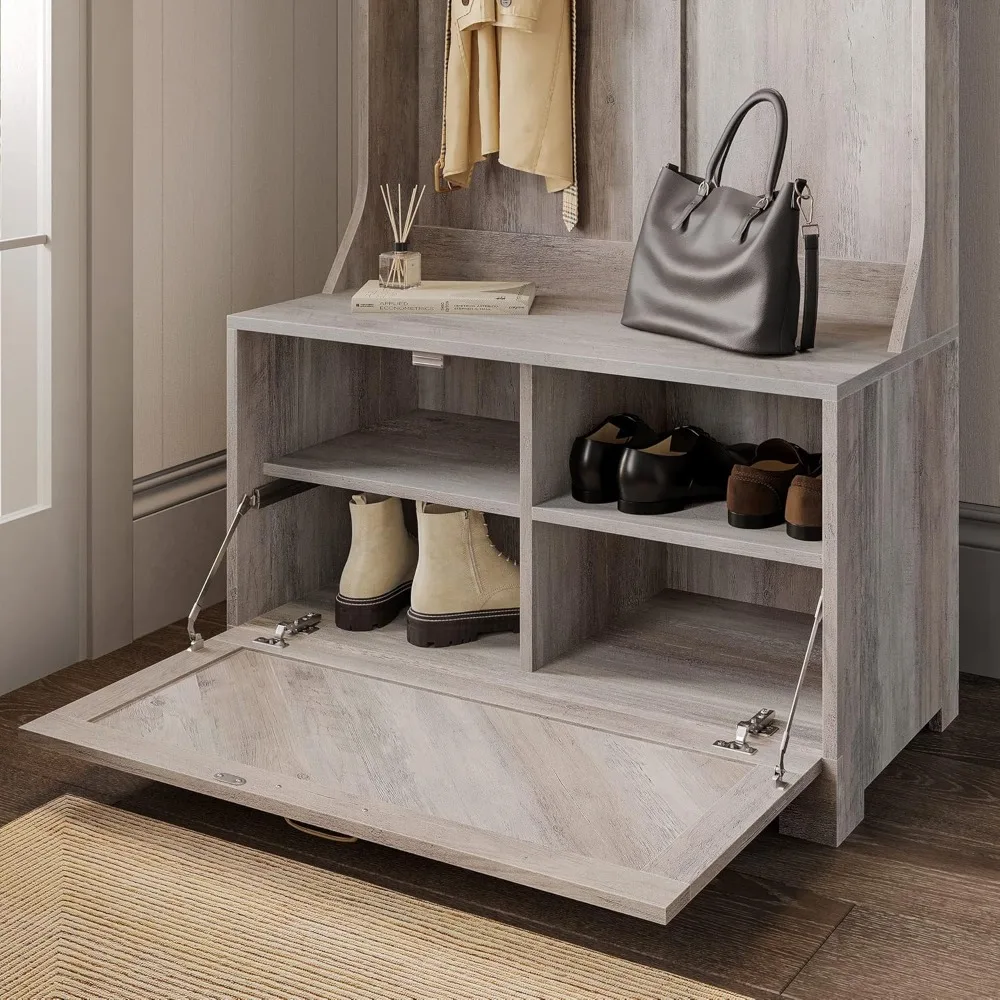
For families that need comprehensive entryway solutions, combining open shelving with a shoe rack bench creates a perfect balance of seating, shoe storage, and display space.
Seasonal Storage Solutions: Rotating with the Calendar
A truly functional mudroom adapts to changing seasons, with storage that transitions smoothly throughout the year. Implementing a seasonal rotation system keeps your mudroom relevant and prevents overcrowding.
Winter Organization:
– Reserve prime shelf space for hats, gloves, scarves, and earmuffs
– Implement water-resistant bins for wet accessories
– Create designated spots for boot dryers and ice scrapers
– Use clear containers to easily locate matched sets of winter accessories
Spring Transition:
– Rotate rain gear to primary accessibility
– Incorporate umbrella stands or hooks within the shelving system
– Create space for gardening gloves and small tools
– Use moisture-resistant containers for wet weather gear
Summer Storage:
– Transition to sunscreen, insect repellent, and sun hats
– Reserve space for beach/pool bags and accessories
– Include water bottle storage for hydration on the go
– Create a designated spot for outdoor game equipment
Fall Preparation:
– Begin rotating light jackets and layers to accessible locations
– Incorporate school and sports equipment organization
– Reintroduce space for light gloves and hats
– Create a system for tracking permission slips and school notices
For those working with limited square footage, techniques for planning a perfect tiny mudroom can help maximize seasonal storage even in compact spaces.
Specialized Activity Centers: Sports & Hobby Equipment
Beyond everyday essentials, open shelving excels at organizing equipment for specific activities that generate specialized gear.
Sports Equipment Solutions:
– Implement vertical ball storage using bungee cords between shelves
– Create helmet stations with individual shelf spaces
– Use deep baskets for protective gear that needs air circulation
– Design tall cubbies for bats, rackets, and other long equipment
Vertical sports organization systems can reduce floor space requirements by up to 70%, making them ideal for compact mudrooms while keeping equipment visible and accessible.
Hobby and Garden Center:
– Design shallow shelving for seed packets and garden plans
– Install tool hooks beneath shelves for hanging garden implements
– Use weatherproof containers for items that might return muddy
– Create drying stations for harvested herbs or flowers
Pet Supply Organization:
– Designate specific shelves for pet essentials (leashes, toys, treats)
– Install hooks under shelving for hanging leashes and collars
– Use sealed containers for treats and food
– Create a station with towels for wiping muddy paws
By thoughtfully organizing these specialized zones, your open shelving becomes a comprehensive solution for all the activities your family enjoys.
Material Selection & Construction: Choosing the Right Shelving System
The performance and longevity of your mudroom shelving depend significantly on selecting appropriate materials that balance aesthetic appeal with practical durability. Each material option offers distinct advantages worth considering.
Material selection determines not just appearance but functionality—especially in mudrooms where moisture, dirt, and heavy use create unique challenges. The right shelving material should withstand years of use while maintaining its appearance and structural integrity.
| Material | Weight Capacity | Moisture Resistance | Price Range | Best For |
|---|---|---|---|---|
| Solid Wood | High (30-50 lbs/ft) | Moderate (needs sealing) | $$$-$$$$ | Traditional aesthetics, customization |
| Metal | Very High (40-60 lbs/ft) | High | $$-$$$ | Industrial look, maximum durability |
| Wire Systems | Moderate (20-30 lbs/ft) | High | $-$$ | Budget options, air circulation |
| Laminate | Moderate (25-35 lbs/ft) | High (sealed edges) | $-$$ | Easy cleaning, color options |
| Glass | Low (10-15 lbs/ft) | Very High | $$$-$$$$ | Modern aesthetic, display focus |
Installation methods add another dimension to consider:
– Floating shelves offer clean lines but typically support less weight
– Bracket-supported shelves provide greater strength but have visible hardware
– Built-in systems offer maximum stability but require more significant installation
– Free-standing units provide flexibility but may sacrifice some stability
When deciding between open versus closed shelving for entryway design, consider how your specific needs align with these material properties and installation options.
Material Performance Factors: Durability Meets Design
Solid Wood Shelving Benefits:
– Supports 30-50 pounds per linear foot depending on thickness and mounting
– Offers warmth and character that complements most home styles
– Can be stained or painted to match existing décor
– Allows for customization through edge profiles and finishes
– Ages gracefully, developing character over time
However, wood requires proper sealing in moisture-prone areas and may expand/contract with seasonal humidity changes.
Metal Shelving Advantages:
– Provides industrial aesthetic that works well in modern and transitional homes
– Supports heavier loads (40-60 pounds per linear foot) with minimal thickness
– Resists moisture damage without special treatment
– Offers exceptional durability in high-traffic areas
– Available in various finishes from matte black to brushed nickel
The primary drawbacks include potential for coldness (both visually and tactilely) and susceptibility to scratches that may expose underlying metal to corrosion.
Composite and Engineered Materials:
– Present consistent appearance without natural variations
– Resist warping and moisture damage better than natural wood
– Available in virtually unlimited colors and patterns
– Generally more affordable than solid wood options
– Require less maintenance over time
For a cohesive look throughout your entryway, consider how wood mudroom benches might complement your shelving material choices for a unified design aesthetic.
Optimal Dimensions: Getting the Measurements Right
Proper dimensions transform ordinary shelving into highly functional storage. Consider these guidelines when planning your mudroom shelving:
Shelf Depth Guidelines:
– 10-12 inches for shoes and small accessories
– 14-16 inches for bags, backpacks, and larger containers
– 16-20 inches for baskets containing bulky items like winter gear
– 6-8 inches for mail, keys, and small daily essentials
Vertical Spacing Recommendations:
– 12-14 inches for shoes and short boots
– 16-18 inches for backpacks and everyday bags
– 8-10 inches for accessory baskets and containers
– 18-24 inches for tall boots or large equipment
Height Placement for Accessibility:
– Position everyday items between 3-5 feet from the floor
– Reserve lower shelves (under 2 feet) for children’s items
– Place less frequently used items above 5.5 feet
– Consider user heights when determining critical shelving zones
Weight Distribution Considerations:
– Install support brackets every 24-32 inches for loaded shelves
– Position heavier items toward the ends of shelves near supports
– Consider wall construction—drywall requires anchor systems while solid wood or concrete provides superior support
– Calculate total anticipated weight before selecting mounting hardware
Styling & Organization: From Functional to Beautiful
The difference between merely functional mudroom shelving and a beautiful, inspirational space lies in thoughtful styling. Strategic organization transforms open shelving from a utilitarian feature into a design highlight that enhances your entire home’s entrance experience.
Effective styling balances practical requirements with aesthetic considerations. The key lies in creating visual harmony through:
- Consistent container styles that complement your overall design theme
- Strategic color coordination between storage elements and room finishes
- Thoughtful incorporation of decorative elements that don’t compromise function
- Varied textures and heights that create visual interest without appearing cluttered
The most successful mudroom shelving displays maintain a 70/30 balance—roughly 70% functional items organized attractively and 30% decorative elements that add personality and style.
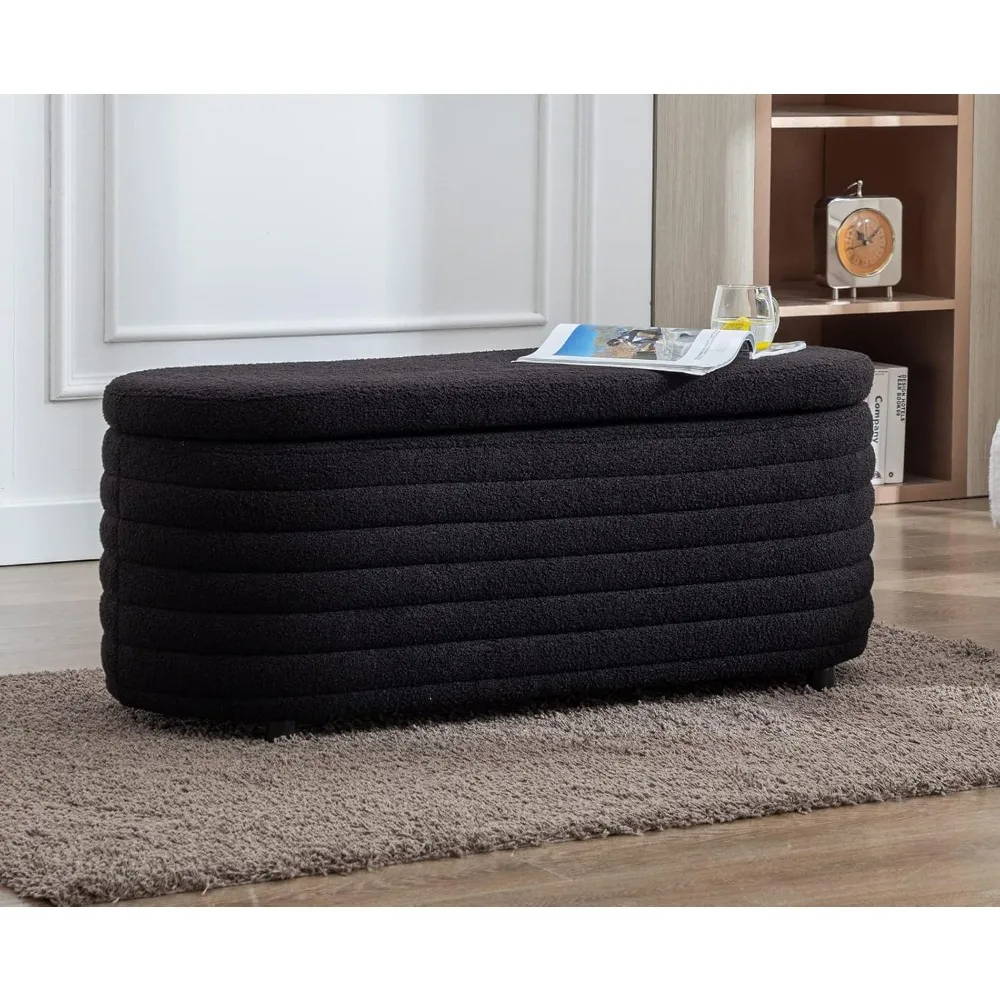
Container Solutions: The Secret to Tidy Open Shelving
Container selection forms the foundation of well-styled open shelving. These organizational workhorses keep small items contained while contributing to the overall aesthetic.
Wire Basket Options:
– Provide excellent visibility of contents while maintaining containment
– Allow air circulation for potentially damp items
– Offer industrial appeal that complements many design styles
– Ideal dimensions: 12×12×8 inches for accessories, 16×12×10 inches for larger items
Fabric Bin Benefits:
– Soften the overall appearance with texture and color
– Conceal smaller, potentially cluttered items completely
– Available in countless colors to coordinate with your design scheme
– Recommended sizes: 12×12×12 inches for winter accessories, 10×6×6 inches for small essentials
Decorative Box Applications:
– Present a more formal, finished appearance
– Completely hide contents for visual serenity
– Offer opportunity to introduce pattern and design detail
– Effective dimensions: 13×15×7 inches for documents and papers, 8×8×4 inches for small valuables
Labeling Strategies:
– Use consistent label styles throughout for visual cohesion
– Consider removable labels for seasonally rotating items
– Implement picture labels for young children’s items
– Choose label materials that complement your containers (metal tags for baskets, fabric tags for soft bins)
For additional inspiration on maximizing limited entry space, exploring space-saving entry benches for small homes offers complementary ideas that work beautifully with well-organized open shelving.
Visual Balance: Creating Aesthetic Harmony
Creating visually balanced shelving requires attention to composition principles that make the difference between cluttered shelves and an artfully arranged display.
The Rule of Three:
Grouping items in odd numbers—particularly threes—creates naturally appealing arrangements. This might mean:
– Three containers of varying heights but similar materials
– Three decorative objects clustered as a visual anchor
– Three color tones that repeat throughout your display
Color Coordination Strategy:
– Choose a limited palette of 3-4 colors that complement your mudroom’s overall design
– Repeat these colors throughout different shelves for cohesion
– Consider how container colors interact with wall colors and flooring
– Use color-blocking for visual impact and organization (e.g., blue bins for winter items)
Incorporating Decorative Elements:
– Place small plants or faux greenery to add life and color
– Include framed family photos in weather-resistant frames
– Add seasonal decorative items that can rotate throughout the year
– Incorporate small artwork or inspirational quotes that reflect your family’s personality
Height Variation Techniques:
– Stagger container heights within the same shelf
– Alternate tall and short items across different shelves
– Use risers or platforms to create height variation among similar items
– Place taller decorative elements strategically as visual anchors
Space-Specific Solutions: Adapting to Your Mudroom Layout
Every mudroom presents unique spatial challenges that require tailored shelving solutions. Whether you’re working with a dedicated mudroom or carving functionality from a hallway or entryway, adaptability becomes essential.
Small or awkward spaces often benefit most dramatically from customized open shelving. By maximizing vertical space, homeowners typically gain 30-40% more storage capacity compared to traditional closed cabinetry in the same footprint. This vertical optimization transforms previously underutilized wall areas into functional storage zones.
For spaces that lack traditional mudroom architecture, strategic shelving placement can actually create the feeling of a dedicated transition zone without structural changes. This zoning effect helps contain outdoor items and prevents them from migrating throughout your home.
For challenging corner spaces or unusual configurations, corner hall tree solutions provide specialized storage that maximizes typically difficult angles while incorporating open shelving principles.
Small Space Maximization: Vertical & Combination Solutions
Limited square footage demands creative approaches that make every inch count. Consider these space-maximizing strategies:
Vertical Maximization Techniques:
– Extend shelving to ceiling height, using the upper shelves for seasonal or less frequently used items
– Implement adjustable shelving systems that can reconfigure as needs change
– Include hooks underneath shelves for hanging items that don’t require shelf space
– Use the full height of narrow walls that might otherwise remain underutilized
Combination Furniture Solutions:
– Integrate small benches for entryways with storage shelving above
– Select narrow profile benches (12-16 inches deep) with open shelving overhead
– Consider wall-mounted folding seats that can collapse when not in use
– Implement corner solutions that utilize typically wasted angular spaces
Slim Profile Options:
– Choose shelving depth of 8-10 inches in high-traffic pathways
– Implement staggered shelf depths (deeper bottom shelves, shallower upper shelves)
– Consider wall-hugging shoe storage with minimal projection into the walkway
– Use vertical dividers to maximize organization within shallow shelving units
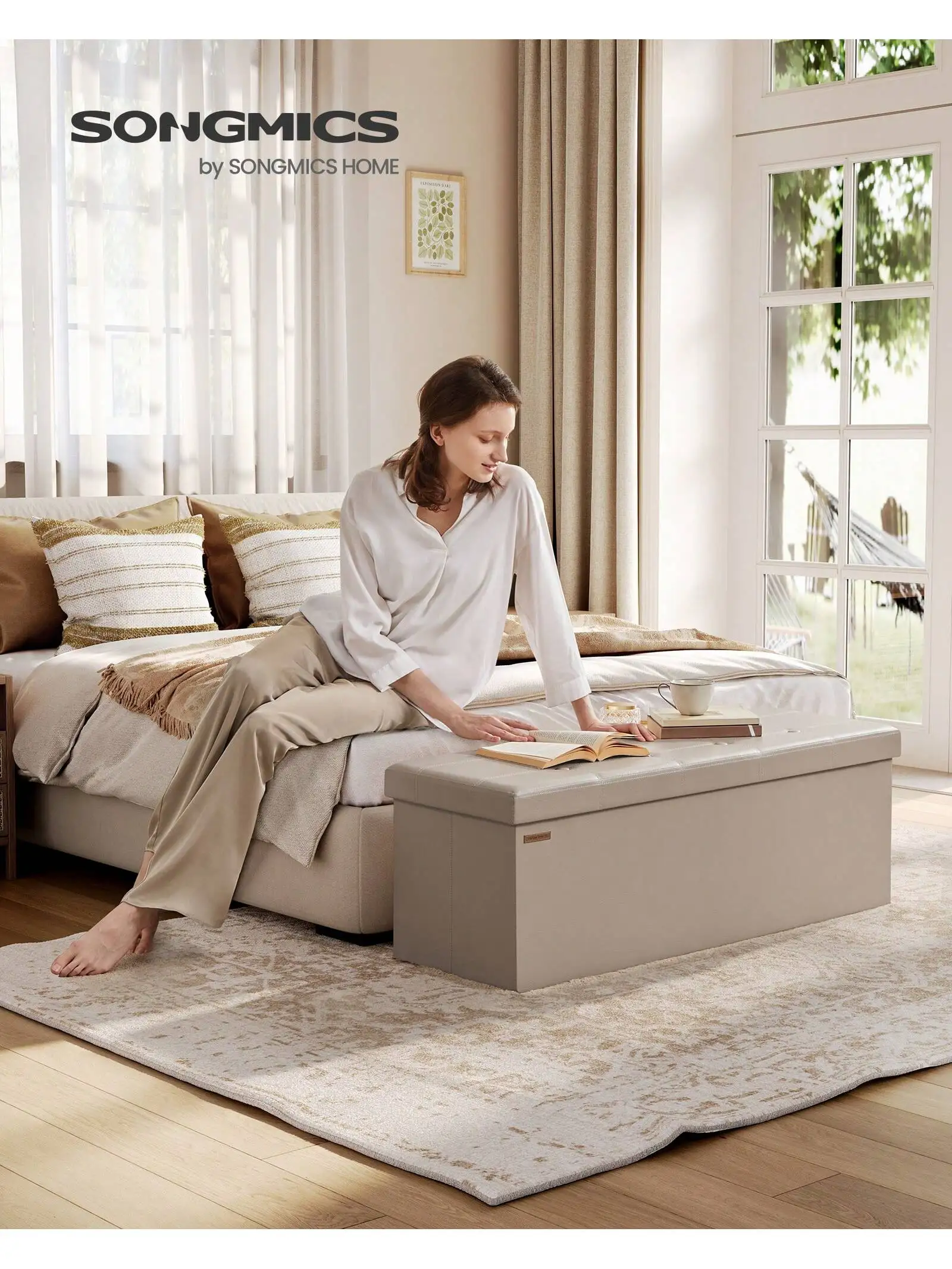
Open Concept Integration: Defined Zones Without Walls
Modern homes often feature open floor plans that lack traditional entry separation. In these spaces, strategic shelving creates definition while maintaining openness.
Creating Visual Boundaries:
– Position shelving units perpendicular to walls to create partial room dividers
– Use shelving heights of 5-6 feet to define spaces without completely blocking sightlines
– Implement two-sided access shelving that serves both entry space and adjacent living areas
– Anchor freestanding shelving units securely to prevent tipping hazards
Maintaining Aesthetic Cohesion:
– Select shelving materials and finishes that complement adjacent living spaces
– Create visual flow through consistent container styles and colors
– Use shelving as a transitional element that bridges design themes between rooms
– Position more decorative elements facing living spaces with functional storage facing the entry
Semi-Private Storage Strategies:
– Place visually appealing items at eye level where they’ll be seen from living spaces
– Position more utilitarian items on shelves oriented away from main living areas
– Use decorative screens or plants as partial visual barriers for necessary but less attractive items
– Implement a combination of open shelving and closed storage for items requiring concealment
Entryway Bench with Cushion, Mudroom Bench with Cushion, Shoe Bench for Entryway
$1,186.63 Select options This product has multiple variants. The options may be chosen on the product pageCoat Rack Shoe Bench, Corner Entryway Bench, Corner Hall Tree, Shoe Bench for Entryway
$313.58 Select options This product has multiple variants. The options may be chosen on the product pageBench with Hooks and Storage, Entryway Hall Tree, Mudroom Bench with Cubbies, Mudroom Bench with Shoe Storage
$818.38 Select options This product has multiple variants. The options may be chosen on the product pageModern Entryway Bench, Wood Entryway Bench, Wood Mudroom Bench
$497.69 Select options This product has multiple variants. The options may be chosen on the product pageEntryway Coat Rack Bench, Entryway Hall Tree, Farmhouse Mudroom Bench, Mudroom Bench with Shoe Storage
$805.09 Select options This product has multiple variants. The options may be chosen on the product pageShoe Bench for Entryway, Shoe Bench for Mudroom, Shoe Rack Bench
$477.04 Select options This product has multiple variants. The options may be chosen on the product page
Maintenance & Sustainability: Keeping Open Shelving Functional
The long-term success of open shelving depends on consistent maintenance routines that preserve both functionality and appearance. Without cabinet doors to conceal disorder, developing sustainable organizational habits becomes essential.
A systematic approach to maintenance transforms what might seem like a chore into a quick, manageable routine:
Weekly Quick Reset:
– Return items to designated locations
– Wipe down frequently touched surfaces
– Assess what’s working and what needs adjustment
– Remove any items that don’t belong in the mudroom
Monthly Deep Organization:
– Clean all shelving surfaces thoroughly
– Evaluate container contents and purge unnecessary items
– Realign systems that may have shifted with use
– Consider upcoming seasonal needs and prepare accordingly
Seasonal Rotation:
– Swap primary access items based on current seasonal needs
– Clean and properly store off-season items
– Refresh any decorative elements to reflect the new season
– Evaluate overall system effectiveness and make adjustments
This maintenance approach ensures your open shelving remains both beautiful and functional while extending the lifespan of your storage system.
Practical Maintenance: The Clean & Tidy Approach
Different shelving materials require specific care approaches to maintain their appearance and integrity:
Wood Shelving Maintenance:
– Dust regularly with a microfiber cloth
– Clean with appropriate wood cleaner quarterly
– Re-seal or refinish as needed every 2-5 years depending on wear
– Address water spots or rings immediately to prevent damage
Metal Shelving Care:
– Wipe down with all-purpose cleaner monthly
– Check for and address any rust spots immediately
– Tighten any loose screws or connectors quarterly
– Apply touch-up paint to chips or scratches as needed
Wire and Composite Maintenance:
– Vacuum dust from wire shelving with brush attachment
– Wipe laminate surfaces with non-abrasive cleaners
– Check for loose components or sagging regularly
– Clean thoroughly before seasonal transitions
Organizational Habits That Prevent Clutter:
– Implement the “one-in, one-out” rule for new acquisitions
– Create a “donation station” basket for items no longer needed
– Designate a specific shelf for incoming items that need processing
– Schedule weekly 10-minute family reset sessions to maintain order
Beyond Storage: Multifunctional Open Shelving Ideas
The most innovative mudroom shelving transcends basic storage to serve multiple purposes simultaneously. With thoughtful planning, your shelving system can evolve into a multifunctional hub that enhances daily life.
Room Division Applications:
– Create partial height dividers (5-6 feet tall) that define spaces while maintaining openness
– Design two-sided units that serve both mudroom and adjacent rooms
– Implement rolling shelving units that can reconfigure as needs change
– Use varying shelf depths to create visual interest while providing functional division
Display Opportunities:
– Reserve specific shelves for rotating seasonal décor
– Create a family photo gallery with weather-resistant frames
– Display children’s artwork in changeable frames
– Showcase natural elements like pinecones, shells, or dried flowers that connect indoor and outdoor spaces
Technology Integration:
– Incorporate charging stations with cord management
– Create tablet holders for digital family calendars
– Install small Bluetooth speakers for morning music or announcements
– Include motion-activated shelf lighting for nighttime visibility
Evolving Family Solutions:
– Design adjustable shelf heights that can change as children grow
– Create modular components that can reconfigure as needs change
– Implement adaptable systems that work for current and future lifestyles
– Consider how spaces might transition when children leave home or family circumstances change
Frequently Asked Questions: Expert Solutions to Common Concerns
How do I prevent dust accumulation on open shelving?
Regular dusting with microfiber cloths makes maintenance simple. For less frequently used items, consider clear containers with lids. Positioning shelving away from high-traffic flooring areas also reduces dust migration. Weekly quick-dusting takes just minutes but maintains a clean appearance.
Won’t open shelving make my mudroom look cluttered?
Thoughtful containment through baskets and bins creates visual order while maintaining accessibility. Limiting your color palette and creating consistent groupings significantly reduces the appearance of clutter. Remember that not every inch needs to be filled—visual breathing room is essential to an organized appearance.
How much weight can typical open shelving support?
This depends on materials and mounting methods. Properly installed solid wood shelving can support 30-50 pounds per linear foot, while metal systems often handle 40-60 pounds per foot. Always check manufacturer specifications and use appropriate wall anchors designed for your specific wall construction.
Should I mix open and closed storage in my mudroom?
Many designers recommend a 70/30 approach—approximately 70% open shelving for frequently used items and 30% closed storage for less attractive necessities or seasonal items. This balance maintains accessibility while providing concealment where needed.
Inspiration Gallery: Real-World Mudroom Shelving Success Stories
Modern Minimalist Transformation
This bright, airy mudroom features white oak floating shelves against a crisp white wall. Simple wire baskets contain essentials while maintaining visual lightness. The homeowners report that the open design encourages better organization habits and makes mornings more efficient.
Farmhouse Functionality
Reclaimed barn wood shelving brings warmth and character to this family mudroom. Custom-built to maximize an awkward corner space, the shelving incorporates vintage crates as dividers and container elements. Personal touches include inherited hooks and family photos that create a welcoming atmosphere.
Urban Apartment Solution
Working with just 12 square feet of hallway space, this clever installation uses floor-to-ceiling metal shelving with varying depths. The system successfully organizes essentials for a family of four without overwhelming their compact entry. Strategic use of matching fabric bins creates visual cohesion.
Before & After: Mudroom Revival
This dramatic transformation converted an underutilized laundry nook into a highly functional mudroom hub. By removing closed cabinetry and implementing open shelving, the homeowners gained 40% more usable storage while making the space feel twice as large. Strategic lighting highlights the well-organized shelves.
Integration with Nested Goods: Finding Your Perfect Shelving Solution
The quality of materials in your mudroom shelving system directly impacts both performance and longevity. Premium construction ensures shelving that withstands the demands of daily use while maintaining its appearance year after year. This investment perspective recognizes that entryway organization forms the foundation of whole-home functionality.
Thoughtfully designed storage systems address not just current needs but anticipate how your requirements might evolve over time. Multi-functional pieces that adapt to changing family dynamics provide superior long-term value compared to single-purpose solutions. When evaluating options, consider how features like adjustable components and modular design enable your system to grow with your lifestyle.
At Nested Goods, we understand that the transition between outdoors and in represents a critical juncture in home organization. Well-designed mudroom systems create ripple effects of organization throughout your entire living space by containing outdoor elements and creating logical homes for everyday essentials. This attention to entryway functionality transforms the daily experience of coming home.

